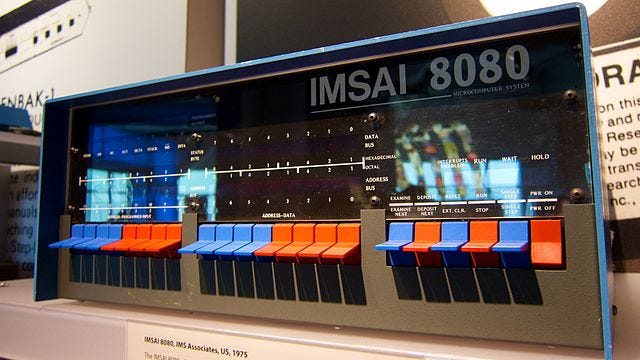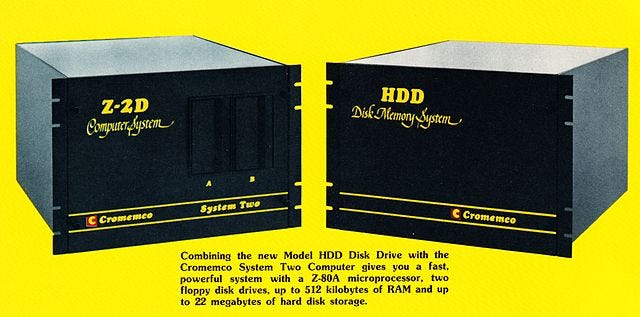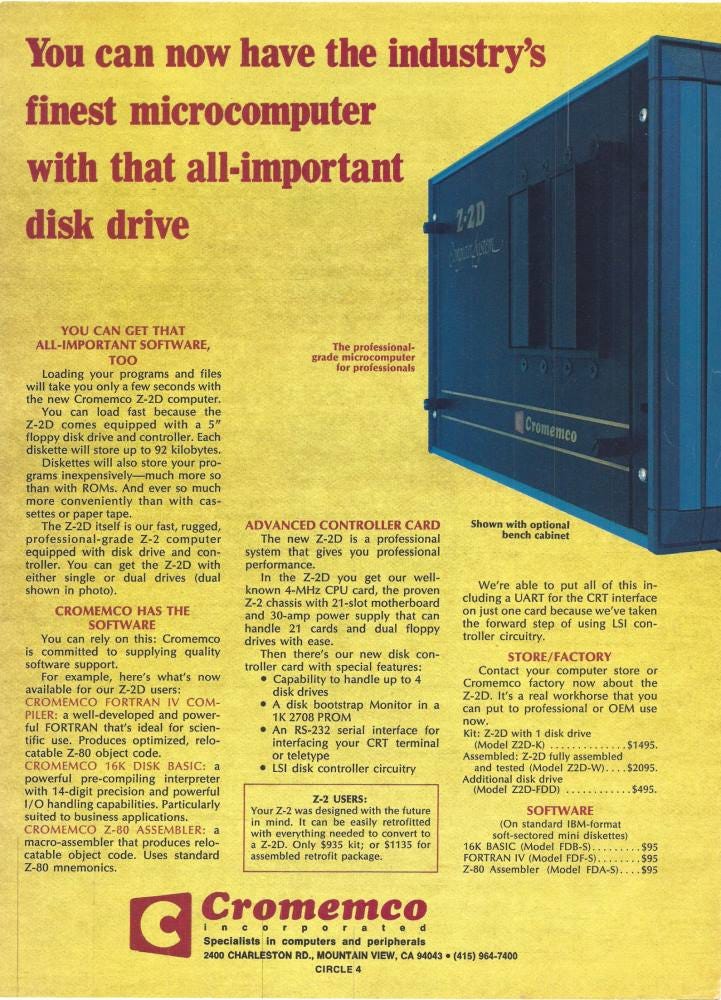Cromemco Z-2D
You can now have the industry's finest microcomputer with that all-important disk drive
The Company
Cromemco was founded in 1974 by Harry Garland and Roger Melen. Both men had been students at Stanford University. The name Cromemco was a reference to the dorm they shared at Stanford, Crothers Memorial.
The company’s first product was the Cyclops digital camera, which was followed by the Dazzler color graphics interface. Both products were groundbreaking. Shortly after their release, Cromemco changed their focus to making computers.

The first Cromemco computer was the Z-1 released in August 1976. The Z-1 was essentially an IMSAI 8080. It was the same chassis, but used a Z80 chip instead of an Intel 8080. Cromemco continued to build computers for years to come. They even created CROMIX, their own Unix-like operating system. Eventually, they switched from Z80 chips to the Motorola 68000.
In 1987, Garland (now the sole owner) sold Cromemco to Dynatech Corporation. The European side of Cromemco was closed in 2018, but the Greek branch still exists, but apparently it doesn’t make computers anymore.
The Computer
The Cromemco Z-2 was released in 1977. It was powered by a Zilog Z80 chip and ran the CP/M operating system. It was available as a kit or assembled. The Z-2 used the S-100 bus system and could support up to 21 add-on boards.

The Z-2D was released in September 1977. It improved on the Z-2 by including 64 KB of ram, one or two Wangco 5¼ inch disk drives, a disk power supply, and a disk controller. (You can see the insides of a Z-2D here and here.)
https://youtube.com/shorts/sk30O2HCgFA
Steven K. Roberts had the following to say about the Z-2D in the June 1979 issue of Kilobaud Microcomputing:
Cromemco has done an admirable job integrating various hardware and software components into an efficient computer system. Originally a producer of “add-ons” for the Altair and IMSAI markets, the company began in 1977 to produce its own S-100-based processor, the Z-2. It was instantly evident that they were addressing existing deficiencies in the field, as the mechanical design was not flimsy and the bus was quiet.
Encouraged by the Z-2’s initial enthusiastic acceptance, Cromemco added the two Wangco minifloppies and their controller, which turn the mainframe into a Z-2D. An operating system called CDOS (originally a derivative of CP/M, now an enhancement thereof) was provided, supporting an excellent assembler, a comprehensive disk BASIC, FORTRAN IV, and recently, COBOL, a word processor, and a data base management system. In late 1977, when it was incorrectly assumed that the majority of microprocessor customers were hobbyists, most manufacturers would have long since engaged in the popular art of laurel-resting.
Throughout my involvement with Cromemco, the two most notable characteristics of the company have been its technical competence and its interest in helping users with problems. The latter is almost dizzying (in light of my hundreds of telephone and UPS dollars spent in the past in fruitless pursuit of factory support from one of the major entities in this strange new industry). Unhomogenized by longevity and complacency, the range of attitudes sported by the system manufacturers ranges from the “You bought it, it’s yours” philosophy, which is most familiar, to Cromemco’s almost embarrassing willingness to devote considerable energy to a problem and, yes, even return phone calls. But enough plaudits; let’s look at specifics.
…
Now, with this effective little interface, the Z-2D can take the place of a system costing more than twice as much. With the ability to produce relocatable code via an assembler, which allows such niceties as conditional assemblies and disk macro libraries, it is almost fun (well, let’s not get carried away) to develop software for external processors or, of course, for the Z-2D itself.
…
It’s easy to stray into the finer points of computer use when talking about the Cromemco system, and while questionable from a literary standpoint, that is a good sign. The best index of a computer system’s value is the extent to which it makes its presence felt: the less the better. The operation of the Z-2D is smooth, reducing to almost zero the occasions when it is necessary to pay attention to the system itself.
We’re into this, most of us, because we see potential in the use of microprocessors as “thought amplifiers.” We are aware that the marriage of the human mind, with all its abstraction and pattern-recognition capability, to the computer, with its swiftness of calculation and flawless memory, offers unprecedented opportunities for creative expression and practical enrichment of our lives.
The less we have to fiddle around with the interface between ourselves and our machines, the better we can address ourselves to the tasks at hand.
In the never-ending asymptotic approach to the ideal, the Cromemco Z-2D remains refreshingly in step with the state of the art.
What computer ads would you like to see in the future? Please comment below. If you enjoyed, please share with your friends and relatives. Thank you.




> The Z-2 used the S-1000 bus
That should be S-100. Ess one hundred, not ess one thousand.
Thanks for doing this - these are fun! One of my favorite computer advertisers that really got me dreaming was The Digital Group. Two other favorite vendors Heathkit and Ohio Scientific. My favorite peripheral was the Teletype Model 43 printing terminal.